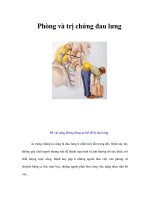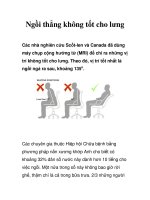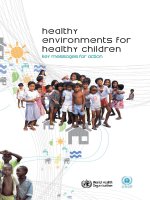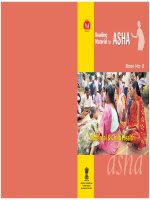Tài liệu Mechanical Ventilation for children with Lung Disease: ALI, ARDS, and Hypoxemic Respiratory Failure. docx
Bạn đang xem bản rút gọn của tài liệu. Xem và tải ngay bản đầy đủ của tài liệu tại đây (2.34 MB, 51 trang )
Mechanical Ventilation for
children with Lung Disease
ALI, ARDS, and Hypoxemic Respiratory
Failure.
How should I manage these patients in
the OR?
Roby Khemani MD MsCI
USC Keck School of Medicine
Childrens Hospital Los Angeles
Case Presentation
• 9 year old male with Leukemia with respiratory
failure from Adenovirus pneumonia.
• 3 days into ICU course develops acute upper GI
bleed.
• Several attempts at endoscopic control of
bleeding unsuccessful.
• Has received 8 units of PRBCs over past 24 hours
and still having ongoing losses.
• Surgical team wishes to take child to OR for
exploratory laparatomy to control bleeding.
Current Support
• Conventional Mechanical Ventilation
– SIMV Pressure Control + Pressure Support
• Rate 20; Peak Inspiratory Pressure 32; PEEP 12; FiO2 0.6
• Last ABG; 7.28/62/60/+3
• Lung Disease Severity Indicators
– PaO2/FiO2 Ratio : 100
– Oxygenation Index (MAP *FiO2/PaO2) *100 = 19
• Fentanyl, Midazolam, Octreotide Infusions
• No inotropes or Vasopressors
Questions?
• How do I identify who is at high risk for
worsening lung injury or poor outcome?
• What type of ventilator management strategy
should I employ for this patient in the
operating room?
• Any other adjuvant therapies/management I
should be considering when managing this
patient interoperatively
Acute Lung Injury; Definitions
American-European Consensus (1994)
Acute Onset
Bilateral infiltrates on Chest Radiograph
PaO2/FiO2 ratio <300 for Acute Lung Injury, <200 for
ARDS
No Left Ventricular Dysfunction
Clinical Syndrome from constellation of causes
Direct Lung Injury (pneumonia, aspiration etc)
Indirect Lung Injury (sepsis, trauma, pancreatitis etc)
Bernard 1994
Epidemiology of ALI in Children
• 2-4% of all PICU pts have ALI
• MV Children (>12-24h)
ARDS: 2-7%
ALI: 6-10%
• LRTI most common trigger
• Indirect Lung Injury from
Sepsis, with worse prognosis (?
More likely MODS)
•Recent estimates of mortality are between 30-40% for
adults and 8-30% for children with ALI or ARDS
Randolph 2009, 2003, Farias 2004, Dahlem 2003, Erickson 2007, Curley 2005, Willson 2005
Risk factors for death
• Mortality for Pediatric ALI and ARDS is less
than that for adults
– Adults have more co morbidities, organ
dysfunction
– Initial degree of oxygen impairment (OI, PF ratio,
LIS) more reliably associated with mortality in
children than adults
– MODS, PRISM, Indirect Injury associated with
mortality
CHLA Data
Mortality =20%; n=398
AHRF=17.5%; n=206
ALI/ARDS= 22%; n=192
ARDS=25%; n=153
Khemani, Conti, Alonzo, Bart, Newth 2009
Markers of Lung Disease Severity
PF: PaO2/FiO2 Ratio
OI: Oxygenation
Index
(MAP *FiO2/PaO2)
*100
Lung Injury Score
(Max 4 points)
•
•
•
•
PF Ratio
PEEP
Crs
Quadrants of
Consolidation, CXR
SF: SpO2/FiO2 Ratio
OSI: Oxygen
Saturation Index
(MAP *FiO2/PaO2)
*100
Lung Injury Score
(Noninvasive)
•
•
•
•
SF Ratio
PEEP
Crs
Quadrants of
Consolidation, CXR
Hammer, Numa & Newth. Pediatr Pulmonol 1997; 23:1176-183
Day 1 OI and Mortality
n=156; ALI
80
0.6
70
0.5
60
Number
40
0.3
30
Mortality
0.4
50
0.2
20
0.1
10
0
0
<8
8-15
15-25
>25
OI
Survivors
Deceased
Mortality
Khemani and Newth, unpublished
CHLA Data
OI by Day
LIS by Day
Odds Ratio (95% CI)
Odds Ratio (95% CI)
95% CI
Odds Ratio
Baseline
Day 1
Day 2
Day 3
Baseline
Day 2
Day 3
PF Ratio by Day
Odds Ratio (95% CI)
Odds Ratio (95% CI)
Crs by Day
Day 1
Baseline
Day 1
Day 2
Day 3
Baseline
Day 1
Day 2
Day 3
Khemani, Conti, Alonzo, Bart, Newth 2009
Pathology/Pathophysiology
Ware 2000
Acute (exudative) Phase
Rapid onset
Edema, effusions, patchy infiltrates on chest film
or CT. Mostly in dependent regions of lungs, with
relative sparing of other areas radiographically,
although may be substantial inflamation.
Diffuse alveolar
damage, PMNS, macrophages and
hyaline membranes, edema in
alveolar spaces, disruption of
alveolar epithelium
Ware 2000
What about Ventilator Induced Lung
Injury?
Toxic Effects of High Fractions of Inspired
Oxygen
High Volume or Pressure relating to increased
permeability and edema in the injured lung
Capillary stress failure from over distention
Cyclic opening and closing of atelectatic
alveoli
Alveolar overdistention plus cyclic opening
and closing leads to increase in proinflammatory cytokines
Ware 2000
Alveolar opening/closing Pressure
Haitsma 2003
Ventilating in a safe zone
•Lower Inflection Point
-Alveolar closing
pressure below this
-Apply enough PEEP
•Upper Inflection Point
-Risk for over
distention above
-Limit pressure/
volume
Based on quasi-static/static
V-P curve
Khemani, Bart, Newth 2007
So what is the evidence
• Limiting Volume/Pressure for overdistention
• Retrospective Pediatric Evidence that VT>10
ml/kg injurious
• Prospective Adult evidence that VT 6ml/kg
better than VT 12 ml/kg, with limited plateau
pressures as well
• Unclear about in between zone (6-10 ml/kg)
VT 11-12 ml/kg; historical data
Albuali 2007
Adult Data on VT
• 5 RCTs comparing high vs low VT strategies
– 3 have shown no benefit on mortality or VFD
• Mean of 10.2-10.6 ml/kg vs 7.2-7.3 ml/kg
- 2 Trials with benefit were closer to 6 vs 12
- The mean tidal volume of the control group in both of
these studies increased by 17-18% after
randomization, with increases in the plateau pressures
of 4-6 cm H20
- Successful trials not only limited VT, but also limited
plateau pressure to <30 cmH20
ARDSNet 2000, Amato 1998, Stewart 1998, Brochard 1998, Brower 1999
Results of ARDSnet Tidal Volume Trial
ARDSNet 2000
ARDSNet 2000
Mode of Ventilation
• Most Adult intensivists use the Assist
Control, Volume control mode of ventilation
– Square wave pattern
• Most Pediatric Intensivists use Pressure
Control, or Pressure Regulated Volume Control
Modes of ventilation
– Decelerating Flow Pattern
Lung Protective Pressure Control
• Permissive Hypercapnea
– Tolerate low pH (<7.15) and do not escalate peak
pressures beyond 35 (40) cmH20
• Limit Peak Pressure; Tidal Volume will vary
based on lung disease severity (targeting 6-8
ml/kg)
• Apply liberal PEEP to minimize FiO2, promote
lung recruitment, and minimize alveolar
collapse









